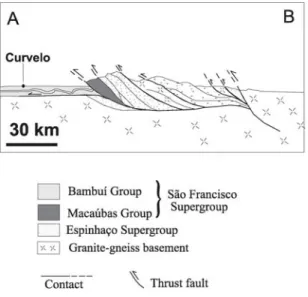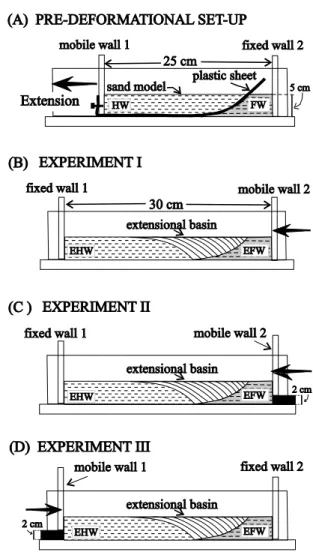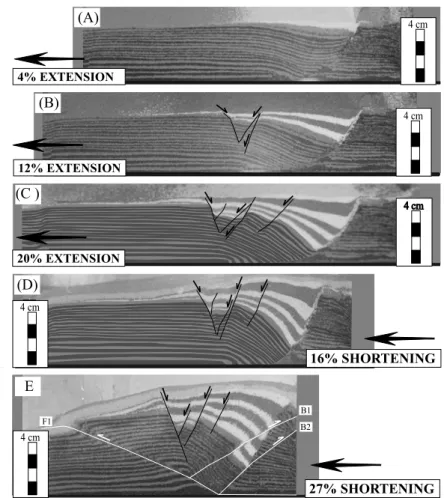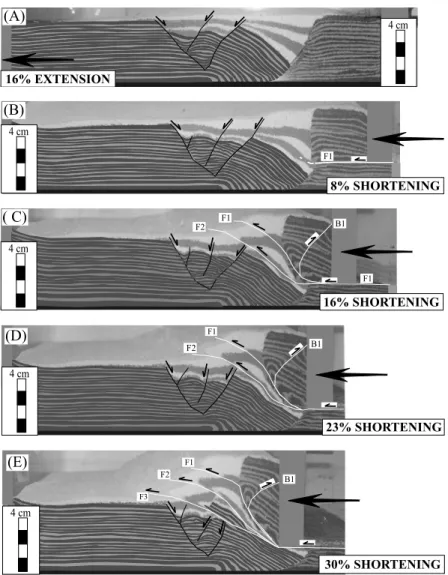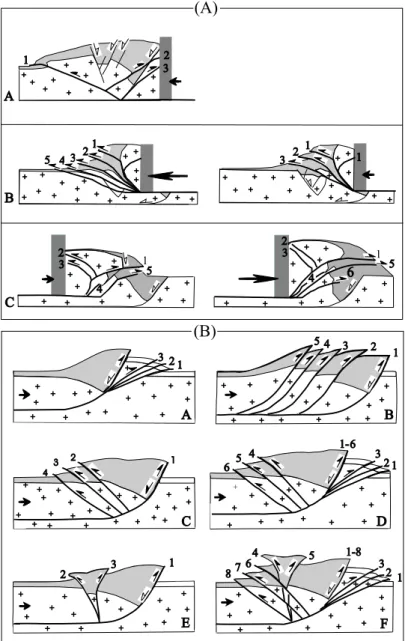www.scielo.br/aabc
Positive inversion of extensional footwalls in the southern
Serra do Espinhaço, Brazil – insights from
sandbox laboratory experiments
CAROLINE J.S. GOMES1, MARCELO A. MARTINS-NETO1and VALÉRIA E. RIBEIRO2 1Universidade Federal de Ouro Preto – Escola de Minas – Departamento de Geologia
Morro do Cruzeiro s/n, 35400-000 Ouro Preto, MG, Brasil
2Companhia Vale do Rio Doce – Departamento de Ferrosos Sul
Serra do Esmeril s/n, 35900-900 Itabira, MG, Brasil
Manuscript received on November 11, 2004; accepted for publication on August 25, 2005;
presented byBENJAMINB. BRITONEVES
ABSTRACT
Analogue experiments were carried out to get insights into the processes governing positive inversion during the foreland propagating thrust tectonics in the southern Serra do Espinhaço, a Brasiliano/Panafrican fold-thrust belt in southeast Brazil. In particular, model listric half-grabens were inverted by applying contractional displacement to the footwall blocks. We investigated two different inversion conditions in listric half-grabens: (i) extensional and contractional detachments at the same level and (ii) at different positions. The models revealed that the development of a forward-breaking thrust system occurs in the basin synrift deposits, by contractional translation of the extensional footwall block when the extensional and contractional master faults do not coincide. Our experiments show the tectonic imbrication between basement and synrift sequences which characterizes the southern Serra do Espinhaço, and support the location in the eastern mountain range domain of the Espinhaço rift master fault system, which is not exposed at the surface.
Key words:experimental modeling, inversion tectonics, footwall block, Espinhaço Basin, different detach-ment levels.
INTRODUCTION
The southern Serra do Espinhaço, a north-south trending, nearly 300 km long mountain range, lies in the external portion of the Late Neoproterozoic Araçuaí belt, a Brasiliano/Panafrican orogenic belt that formed on the eastern margin of the São Fran-cisco craton, in southeastern Brazil (Fig. 1). The Serra do Espinhaço is a west-verging thrust-fold belt originated by positive inversion of pre-existing extensional structures. The architecture of these
Correspondence to: Caroline Janette Souza Gomes E-mail: caroline@degeo.ufop.br
faults is still a matter of debate. According to Dussin and Dussin (1995), the inverted basin was rather symmetrical, with opposite-dipping bound-ary faults, and Martins-Neto (1998, 2000) proposed a rift architecture developed above a west-dipping master fault located in the eastern portion of the Espinhaço range. In this case, a stimulating hypo-thesis suggested by the dominant westward ver-gence of the Brasiliano/Panafrican event is that basin inversion may have occurred by translation of extensional footwall blocks over newly formed low-angle thrust faults (Fig. 2).
inves-Fig. 1 – Simplified geologic-structural map of the southern Serra do Espinhaço and its setting at the São Francisco craton (modified from Schobbenhaus et al. 1984 and T.M. Dussin, unpublished data).
Fig. 2 – Conceptual cartoon showing (A) the classical scheme of hanging wall block inversion (McClay and Buchanan1992), and (B) the authors’ idea of the southern Serra do Espinhaço footwall block inversion. Arrows indicate sense of displacement of the moving wall.
tigate the possibility of positive inversion occurring in a listric half-graben in response to the contrac-tional displacement of the footwall block, instead of reactivating the hanging wall, as commonly pro-posed (e.g. McClay 1989). In recent years, many
and McClay 1991, McClay and Buchanan 1992). These experiments show how structures progres-sively develop in the laboratory, providing coherent solutions and kinematic pathways that help unravel-ing the evolution of complex natural fault patterns.
We designed physical models to obtain new insights for the interpretation of the severely over-printed and badly exposed structural assemblage of the southern Serra do Espinhaço, where no geo-physical data are available. The experiments pre-sented here were carried out at the Laboratory of Tectonic Modeling in the Department of Geology at the Federal University of Ouro Preto. In our mod-els, contractional translation of the footwall blocks occurred along basal detachments situated either at the same position of the listric extensional one, or at a higher level within the experimental multilayer. The latter situation represents an alternative mecha-nism of positive inversion for Precambrian tectonic events separated by a long period of time (more than 1.0 Ga). The physical reason for imposing in our ex-periments the upward migration of the basal detach-ment from extension to contraction is the supposed increase of the temperature gradient through time (McKenzie and Weiss 1975).
Fig. 3 – Regional W-E cross-section along the southern Serra do Espinhaço (see Fig. 1 for location) (modified after Dossin et al. 1992).
THE SERRA DO ESPINHAÇO INVERSION STRUCTURE
Fig. 4 – Geological map of the Espinhaço tectono-stratigraphic units of the central part of the Serra do Espinhaço (see Fig. 1 for location) showing paleocurrent rose diagrams (with numbers of measurements) for different localities, and a not-scaled cross-section (modified from Martins–Neto 2000).
successions occur. Martins-Neto (2000) also argued that the relatively thin rift sequence preserved in the western and central domains of the Serra do Espi-nhaço (ca. 1300 m thick) represents only the exter-nal portion of the synrift wedge, origiexter-nally located close to the rift flexural border (Fig. 5). Evidence of linkage between this sequence and a master exten-sional fault is lacking.
ANALOGUE MODELING
SCALING
Fig. 5 – Block-diagram showing the architecture of the Espinhaço rift, according to Martins-Neto (2000). Inset indicates the area where the synrift deposits occur with limited thickness in the western domain of the Serra do Espinhaço.
represents a good analogue material of upper crustal rocks since it can simulate time-independent defor-mation and fails according to the Coulomb-Mohr law (e.g. McClay and Ellis 1987, Davy and Cob-bold 1991).
The thickness of the brittle basement, our pre-rift sequence, was chosen to simulate the geologi-cal situation of a graben produced in a rigid base-ment comparable to that of the Espinhaço Basin. We achieved the similarity in geometry by using a length ratio of 10−5, such that our 5 cm-thick sand pack corresponds to 5 km in nature.
EXPERIMENTALMETHOD
Three models (experiments I, II and III) were pre-pared in a 30 cm-wide deformation rig, with an ini-tial length of 25 cm parallel to the transport direc-tion and a height of 5 cm (Fig. 6). Each model run involved extensional deformation (Fig. 6A) over-printed by contraction. The extensional basins were inverted by moving mobile wall 2 in experiments I and II (Figs. 6B and C), and by mobile wall 1 in experiment III (Fig. 6D). In experiment I, both the extensional and contractional basal detachments were located at the same stratigraphic level. In the experiments II and III the bottom of walls 2 and 1, respectively, was elevated by 2 cm in order to local-ize the contractional detachment at a higher strati-graphic level with respect to the extensional one. In experiment III we investigate the contractional
translation of the former extensional hanging wall, locating the two basal detachments at different po-sitions.
Deformation was applied by a mobile wall driven by an electric motor at a constant velocity of 2 cm/h. The amount of stretching in step 1 was 5 cm in all experiments, representing 20% extension. The total amount of shortening in step 2 (i. e., basin closure) was 8 cm (27%), 9 cm (30%) and 15 cm (50%) for experiments I, II and III respectively.
We employed dyed and sieved dry quartz sand (average grain size 200-300µm), with an internal friction angle of 34◦(Gomes et al. 1998). The sand pack used in the models contained a succession of 16 dyed layers to help visualization of the individual structures and to highlight deformation. Extension was accompanied by synchronous sedimentation in the graben using sand layers of new colors. In all the experiments, a plastic sheet was introduced in the experimental box before the deposition of the sand pack, in order to impose the location and ge-ometry of the listric normal fault. The plastic sheet was attached to mobile wall 1 and partly covered the model base (Fig. 6A). The other sheet end was carefully molded during deposition of the sand to achieve a curved geometry. The dip of the exten-sional ramp was about 60◦, as commonly observed in nature. After completion of the extension, the plastic sheet was detached from the mobile wall 1 and removed prior to the inversion process. To re-move the plastic sheet we pulled it carefully without causing any damage to the sand pack.
Photographs of the evolving structures were taken at regular intervals through the transparent sidewalls. At the end of each experiment, the mod-els were wetted and sections were sequentially cut, parallel to the tectonic transport direction, to analyze possible distortion of deformation at the sidewalls. These sections have shown that friction between the sand and the glass sides causes a minor slip of the fault-blocks at the sidewalls than in the sand pack center. Since the overall structural architecture is comparable, we present photographs taken at the sidewalls.
EXPERIMENTLIMITS
Our experiments did not account for compaction and thermal effects, as well as for the flexural and isostatic response of the lithosphere. Pore fluid pres-sure effects were also not considered in present study even though Cobbold et al. (2001) demonstrated that the style of deformation in sandboxes could be partially controlled by the amount of fluid pressure. Our experimental multilayers did not include com-petence contrasts that are typical of the upper crust. Finally, it has to be emphasized that our work con-cerns simulation of Proterozoic deformation, where uncertainties about deformation processes and rock mechanics are still greater than in the Phanerozoic time (Marshak 1999). All the above mentioned limitations, despite being important, are shared with most analogue modeling works (e.g. Buchanan and McClay 1991, Allemand and Brun 1991, McClay and Buchanan 1992). Our simplified approach is justified by the purpose of providing basic guides for the understanding of inversion tectonics when con-tractional displacement is applied to the footwall block. Keeping the experiments as simple as possi-ble allowed us to avoid additional complications not directly related to the basic tectonic process under investigation.
EXPERIMENTAL RESULTS
EXPERIMENTI
In experiment I, extension started with a gentle flexure in the hanging wall (Fig. 7A). Stretching of 12% produced a well-developed rollover anticline with a crestal collapse graben system including an-tithetic and synthetic faults (Fig. 7B). The curvature of the rollover anticline increased with progressive extension and faulting propagated towards the listric normal fault (Fig. 7C).
anticli-Fig. 7 – Photographs illustrating successive stages of experiment I. (A) to (C) are cross-sections of the extension, and (D) to (E) of the inversion stage. Note, in the extensional stage, the progressive formation of a rollover anticline with a crestal collapse graben in the extensional hanging wall, and, in the inversional stage, the development of a new thrust system in the pre-rift sequence. F- forethrust; B-backthrust; numbers indicate thrust formation order. Black lines outline the traces of the crestal collapse graben normal faults and white lines the traces of the new thrust faults.
nal curvature accentuated (Fig. 7D). The progres-sive shortening caused the development of one ma-jor forethrust and two backthrusts (Fig. 7E). Those structures propagated, respectively, into the exten-sional hanging wall and footwall, cutting the old master normal fault. The uplift associated with in-version was slightly asymmetric since it concen-trated above the backthrusts. No reactivation of syn-rift antithetic and synthetic faults occurred until the final stage of inversion (27% of shortening).
EXPERIMENTII
verti-cally stretched (Fig. 8C) and then pushed upwards. At 16% of shortening, two forethrusts developed in the synrift sequence (F1 and F2) and one backthrust (B1) in the deformable backstop. Forethrusts cut the older normal detachment and the synthetic crestal collapse faults. The translating extensional footwall compressed the basin fill during progressive shorten-ing, trapping its deepest domain (Fig. 8D). At high-est shortening (30%), a third forethrust (F3) devel-oped in the prerift and cut the upper domain of the normal rollover anticline transporting a prerift sheet into the synrift sequence (Fig. 8E). No reactivation of the antithetic crestal collapse fault was observed.
EXPERIMENTIII
Figure 9A shows experiment III after 20% of ex-tension, characterized by a rollover anticline and a crestal collapse graben structure that compare well with those in experiments I and II. After 16% of shortening (Fig. 9B) inversion produced slightly asymmetric uplift of the extensional hanging wall block with two blind forethrusts (F1 and F2) and a well developed backthrust (B1). The antithetic cre-stal collapse graben fault (C1) was passively rotated, causing tightening and slight uplift of the collapse graben infill. The increasing contractional deforma-tion (33% of contracdeforma-tion, Fig. 9C) produced strong vertical strain in the extensional hanging wall with counterclockwise rotation and reactivation of faults F1 and F2. The oldest thrust fault (F1) accommo-dated the highest displacement, cutting the normal crestal collapse fault C1 and connecting to the for-mer extensional fault C3. Fault C3 was reactivated as a thrust fault and translate part of synrift sediments out of the crestal collapse graben. In addition, a new backthrust (B2) formed in the hinterland and, in the foreland, synthetic crestal collapse fault C2 became reactivated as a thrust fault (F3).
Figure 8D shows the deformation after 50% of shortening. A new forethrust (F4) developed and, as dislocation on the individual faults increased, short-ening produced a classical antiformal stack with overlapping thrust horses and a coincident trailing branch line.
DISCUSSION
COMPARISONAMONGANALOGUEMODELS
The three experiments described above show com-pletely distinct styles of deformation (Fig. 10(A)). In experiment I, development of a major pop-up-like structure forced the whole extensional basin to uplift, with minor deformation in the basin infill. In experiment II, a forward-breaking thrust system caused the forelandward translation and uplift of the thicker part of the former extensional basin. Pre-rift sheets were pushed into the synPre-rift sequence. The differences shown by models I and II, in the in-version stage, are a direct consequence of the com-pressional basal detachment position. Its location at the base of the sand pack produced, in experiment I, the nucleation of the first thrust ramp (1) below the basin sequence. In experiment II, the higher location of the basal detachment caused thrusting to nucleate in the interior of the synrift sequence, adjacent to the listric ramp of the master extensional fault. The younger thrusts cut syn- and prerift sequences.
Fig. 8 – Photographs illustrating successive stages of experiment II. (A) presents a rollover anticline with a crestal collapse graben, similar to that of experiment I; and (B) to (E) the sequential inversion. In the inversional stages, note the progressive counterclockwise rotation of the listric detachment and the development of a new thrust system. F- forethrust; B- backthrust; numbers indicate thrust formation order. Black lines outline the traces of the crestal collapse graben normal faults and white lines the traces of the new thrust faults. The synrift sequence is represented by light gray and white layers.
COMPARISONSWITHPREVIOUSANALOGUEMODELS
Extensional geometries produced in our models compare well with those obtained by McClay and Ellis (1987), which were set up with a rigid foot-wall. In all experiments, the extensional basin was characterized by classic rollover anticlines and cre-stal collapse graben structures.
Fig. 9 – Photographs of experiment III. (A) presents a rollover anticline with a crestal collapse graben, similar to that of experiment I; and (B) to (D) the sequential inversion. Note, in the inversional stage, the sequential development of an antiformal stack. C- normal faults in the crestal collapse graben; F-forethrust; B- backthrust; numbers indicate fault formation order. Black lines outline the traces of the crestal collapse graben normal faults and white lines the traces of the new thrust faults. The synrift sequence is represented by light gray and white layers.
might be expected. The authors concluded that inversion architecture depends on the pre-existing extensional detachment geometry and the amount of basin closure. The comparison between their dip-slip inversion of a listric fault system and the experiments presented here suggests that an addi-tional item may influence inversion-architecture: the moving fault block (Fig. 10). One of the most striking features of inversion produced in our exper-iments is that thrusts form a completely new thrust system.
COMPARISONS WITH FIELD EXAMPLES DESCRIBED IN THELITERATURE
fea-Fig. 10 – Cartoons illustrating conceptual models for positive inversion. (A) Our models: A- Experiment I; B- Experiment II; and C- Experiment III (note the progressive shortening in experiments II and III). (B) The dip-slip inversion of a listric fault system presented by McClay and Buchanan (1992) (modified from McClay and Buchanan 1992): A- Imbricate fan of back’ footwall shortcut thrusts; B- ‘break-back bypass’ thrusts; C- imbricate fan of ‘forward-breaking’ ‘break-backthrusts; D- fan structure of ‘break-backthrusts and footwall shortcut thrusts; E- crestal collapse ‘pop-up’ structure; and F- combined model.
tures that were also produced in our experiments, such as the trapping of the rift fills in the hinter-land of the inverted basin, the development of a thrust system in the foreland and the introduction
Fig. 11 – (A) The McCook half-graben of the Kechika Trough, Canada, a basin closed by the footwall of an extensional detachment (simplified from McClay et al. 1989). (B) An idealized representation of the west Alp basin, closed by the footwall of an extensional detachment (modified from Butler 1989).
Alps (Fig. 11B). Both architectures are in good agreement with our experiment II. In addition, Mc-Clay et al. (1989), Hayward and Graham (1989) and Knott et al. (1995) proposed that, during the pro-gressive evolution of basin inversion, rotation of the normal detachment ramp occurs until complete in-version. The evolution of an “overturned normal fault” can be seen in our physical model II (Fig. 8).
INSIGHTS FOR THE EVOLUTION OF THE SOUTHERN
SERRA DOESPINHAÇOSTRUCTURE
Even though analogue models are oversimplifi-cations of natural processes, the deformation style described in our experiments may be illustrative for the Serra do Espinhaço inversion structure. Model II shows one of the most important features of the southern Serra do Espinhaço: the imbrication be-tween basement and synrift sequences. In addition, the imbricate thrust system developed during the in-version of the extensional footwall block is similar to that found in the southern Serra do Espinhaço (Dossin et al. 1992, Alkmim et al. 1993). It sup-ports the location of the rift master fault at the moun-tain range eastern domain, as proposed by Martins-Neto (2000). For a rift master fault located at the west portion of the southern Serra do Espinhaço, the frontal inversion would have been caused by the
reversal of extensional hanging wall block. In this case, an anticlinal stack would have formed with high-angle fore- and backthrusts. High-angle faults, however, are only locally described in the southern Serra do Espinhaço, and a regional scale anticlinal stack is unknown.
CONCLUSIONS
Our experiments demonstrate that in a positive in-version environment, when the contractional trans-lation occurs along a basal detachment situated at a higher level with respect to the listric extensional one, the structural pattern greatly depart from the classic inversion pattern described until now in sandbox experiments. A new thrust system forms with tectonic imbrication between pre- and synrift sequences. Contractional translation of the exten-sional footwall block strongly favors the develop-ment of an imbricate thrust system. In contrast, translation of the extensional hanging wall block produces an antiformal stack.
The experiment II, with extensional and tractional detachments at different levels, and con-tractional translation of the extensional footwall block, represents a good analogue for the southern Serra do Espinhaço thrust-fold belt.
ACKNOWLEDGMENTS
We thank financial support from Fundação de Amparo à Pesquisa do Estado de Minas Gerais (FAPEMIG) (process CEX 2637/97). C.J.S. Gomes and M. Martins-Neto acknowledge researcher fel-lowships from Conselho Nacional de Desenvol-vimento Científico e Tecnológico (CNPq) (pro-cesses 300487/89-4 and 300404/94-8).
RESUMO
Em experimentos de areia foi simulada a inversão positiva com o intuito de investigar os processos que governam a tectônica da Cordilheira do Espinhaço Meridional na borda sudeste do Cráton São Francisco. Analisou-se, em particular, a evolução progressiva de hemigrabens, com falha de borda lístrica, na qual o fechamento da bacia ocorreu através da translação do bloco do muro da falha mestra. Duas condições foram investigadas: (i) os desco-lamentos distensivos e compressivos ocorrem na mesma cota e (ii) os descolamentos situam-se em posições difer-entes. Os modelos revelaram que um sistema de falhas de cavalgamento com estilo colapso da lapa se desenvolve no interior do depósito sinrift quando os descolamentos não coincidem. O imbricamento entre escamas do pré- e sinrift, nos modelos, permite esboçar uma analogia com a tectônica da porção sul da Cordilheira do Espinhaço e situar a falha de borda, mestra, que não aflora, na sua ex-tremidade leste.
Palavras-chave:modelagem experimental, inversão tec-tônica, bloco do muro, Bacia Espinhaço, descolamentos em cotas diferentes.
REFERENCES
ALKMIM FF, BRITO NEVES BB AND ALVES JAC.
1993. Arcabouço tectônico do Cráton São Francisco – uma revisão. In: DOMINGUEZ JML AND MISI
A (Eds), O Cráton São Francisco, p. 45–62.
ALLEMAND P AND BRUN JP. 1991. With of conti-nental rifts and rheological layering of the lithosfere. Tectonophys 188: 63–69.
ALMEIDAABREUPA. 1995. O Supergrupo Espinhaço da Serra do Espinhaço Meridional (Minas Gerais): o Rifte, a Bacia e o Orógeno. Geonomos 1: 1–18. BUCHANANPGANDMCCLAYKR. 1991. Sandbox
ex-periments of inverted listric and planar fault systems. Tectonophys 188: 97–115.
BUTLER RWH. 1989. The influence of pre-existing
basin structure on thrust system evolution in the West-ern Alps. In: COOPERMA ANDWILLIAMSGD (Eds), Inversion Tectonics. Geol Soc London Spec Pub 44: 105–122.
COBBOLDPR, DURANDSANDMOURGUESR. 2001. Sandbox modelling of thrust wedges with fluid-assisted detachments. Tectonophys 334: 245–258. DAVY PH ANDCOBBOLDPR. 1991. Experiments on
shortening of a 4-layer model of the continental litho-sphere. Tectonophys 188: 1–25.
DOSSINIA, DOSSINTM, CHARVETJANDCHEMALE
JR F. 1992. Tectonique du Protérozoique superior au sud-est du Craton São Francisco (Minas Gerais, Brazil). C R Acad Sci Paris 317-II: 629–636. DUSSINIAANDDUSSINTM. 1995. Supergrupo
Espi-nhaço: Modelo de Evolução Geodinâmica. Geono-mos 1: 19–26.
GOMESCJSANDFERREIRAJE. 2000. Geometry and
Kinematics of Experimental Antiformal Stacks. An Acad Bras Cienc 72: 195–217.
GOMESCJS, VIEIRA JF ANDSEABRA GOMESAA. 1998. O ângulo de atrito interno da areia e de mis-turas de areia. In: CONGRESSO BRASILEIRO DE
GEOLOGIA40, Salvador, BA, Brasil, p. 410–411. HAYWARDABANDGRAHAMRH. 1989. Some
geo-metrical characteristics of inversion. In: COOPER
MA ANDWILLIAMSGD (Eds), Inversion
Tecton-ics. Geol Soc London Spec Pub 44: 17–39. HERRGESELLGANDPFLUGR. 1986. The Thrust belt
of the Southern Serra do Espinhaço, Minas Gerais, Brazil. Zeitbl Geol Paläont 1: 1405–1414.
HUBBERTMK. 1937. Theory of scale models as applied to the study of geological structures. Geol Soc Am Bull 48: 1459–1520.
KNOTT SD, BEACH A, WELBON AI AND BROCK
-BANKPJ. 1995. Basin Inversion in the Gulf of Suez: Implications for exploration and development in failed rifts. In: BUCHANANJGANDBUCHANAN
PG (Eds), Basin Inversion. Geol Soc London Spec Pub 88: 59–81.
MARSHAKS. 1999. Deformation style way back when: thoughts on the contrast between Archean/Paleopro-terozoic and contemporary orogens. J Struct Geol 21: 1175–1182.
MARSHAK S AND ALKMIM FF. 1989. Proterozoic Contraction/Extension Tectonics of the Southern São Francisco Region, Minas Gerais. Brazil. Tectonics 8: 555–571.
MARTINS-NETOMA. 1993. Sedimentary evolution of
a Proterozoic rift basin: the basal Espinhaço Super-group, southern Serra do Espinhaço, region of Dia-mantina, Minas Gerais, Brazil. Freiburger Geowiss Beitrag 4: 1–155.
MARTINS-NETOMA. 1998. O Supergrupo Espinhaço em Minas Gerais: Registro de uma bacia rifte-sag do Paleo/Mesoproterozóico. Rev Bras Geocienc 28: 151–168.
MARTINS-NETOMA. 2000. Tectonics and sedimenta-tion in a paleo/mesoproterozoic rift-sag basin (Espi-nhaço Basin, southeastern Brazil). Precambr Res 103: 147–173.
MCCLAY KR. 1989. Analogue models of inversion tectonics. In: COOPER MAANDWILLIAMSGD (Eds), Inversion Tectonics. Geol Soc London Spec Pub 44: 41–59.
MCCLAYKRANDBUCHANANPG. 1992. Thrust faults
in inverted extensional basins. In: MCCLAY KR (Ed), Thrust Tectonics, p. 93–104.
MCCLAYKRANDELLISPG. 1987. Analogue models of extensional fault geometry’s. In: COWARDMP
ET AL. (Eds), Continental Extensional Tectonics. Geol Soc London Spec Pub 28: 109–125.
MCCLAYKR, INSLEYMWANDANDERTONR. 1989. Inversion of the Kechika Trough, Northeastern British Colombia, Canada. In: COOPERMA AND
WILLIAMS GD (Eds), Inversion Tectonics. Geol Soc London Spec Pub 44: 235–257.
MCKENZIEDANDWEISSN. 1975. Speculations on the
thermal and tectonic history of the earth. Geophys J Royal Astron Soc 42: 131–174.
PFLUGR. 1965. A geologia da parte meridional da Serra
do Espinhaço e zonas adjacentes. Rio de Janeiro, DNPM/DGM. Boletim 226: 51.
PFLUGRANDRENGERFE. 1973. Estratigrafia e evolu-ção geológica da margem SE do Cráton Sanfrancis-cano. In: CONGRESSO BRASILEIRO DE GEOLO
-GIA27, Aracajú, SE, Brasil, p. 5–19.
SCHOBBENHAUSC, CAMPOS DA, DERZEGR AND
ASMUSHE. 1984. Mapa geológico do Brasil e da
Área Oceânica Adjacente, Ministério das Minas e Energia/Departamento Nacional da Produção Mine-ral, Brasília, 501 p.
SCHÖLLWUANDFOGAÇAACC. 1979. Estratigrafia da Serra do Espinhaço na região de Diamantina. In: SIMPÓSIOGEOLOGIAMINASGERAIS(1). Bole-tim 1: 55–73.
SILVA RRANDTOLEDO CLB. 1993. A Proterozoic
duplex thrust system in the southern Serra do Espi-nhaço, Minas Gerais, Brazil. Zeitbl Geol Paläont 1: 55–66.
UHLEIN A, TROMPETTE R AND EGYDIO-SILVA M. 1995. Rifteamentos superpostos e tectônica de in-versão na borda sudeste do Cráton São Francisco. Geonomos 1: 99–107.
VENDEVILLE B, COBBOLD PR, DAVY P, BRUN JP
AND CHOUKROUNE P. 1987. Physical models of
extensional tectonics at various scales. In: COWARD

